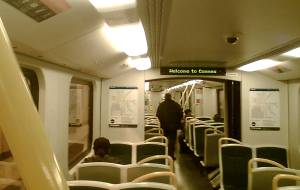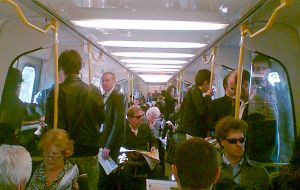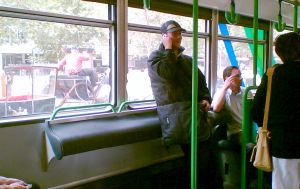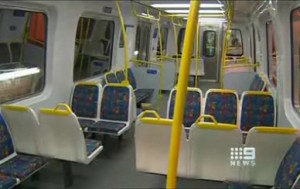

No straps to hold onto / Standing in the doorways is easiest
Connex has a proposal to reduce the number of seats in some trains, as well as other internal carriage changes, including changing the doorways, and putting in more handholds.
…Flashback…
Almost six years ago, I took my newly purchased Canon A70 digital camera out to the mean streets of Fitzroy, to take pictures of John C holding a foldable chair at a tram stop, for a PTUA brochure entitled “Yarra Trams – BYO Seat“, protesting over the removal of seats from B-class trams, which also featured an image of “Yarra Sardines”.
In fact, Yarra Trams were so riled up by the brochure that they threatened legal action.


Apollo tram bum rack seats / Modified Comeng train layout (pic: Channel 9)
So, what’s different about the new Connex proposal to remove seats from trains?
1. It’s less seats removed. The “Apollo” tram layout saw 28 out of the 74 seats came out — around 38%. This time it’s 44 out of 268 (per 3 carriages) — about 16%.
2. The removal of seats from trams was about squeezing more people in, when a better solution would have been to put on more trams. This time, it’s also about better using the existing space down the aisles, and getting people away from the doors, to speed up loading/unloading “dwell” times so that more trains can run. This is particularly a problem at CBD stations in rush hour, when the theoretical dwell time is 30 seconds, but reality can be three or four times that much because the last lot of refurbishments led to a really hopelessly inefficient design that encourages people to block the doors. Quicker loading = more trains can run = less crowding (and probably no overall reduction in seating).
3. The change is being accompanied by lots more rails/poles, largely solving the current problem of having almost nothing to hold onto when standing in some spots.
4. This time around, they actually mentioned it to people before doing it, and explained why, and are keen to have people see it on a demonstration train, and discuss the changes, rather than presenting it as a fait accompli.
It’ll be interesting to see what people think when they see it. I’ve already heard a range of opinions, varying from “outrageous, they shouldn’t take away any seats” to “why don’t they take out all the seats”? I suspect there’s a balance to be found somewhere there.
And it’ll be interesting to see how effective it is at reducing dwell times.
23 replies on “Less seats”
I don’t entirely agree with the whole concept of removing the seats – more trains would be the sensible solution – but why not throw those bum rack seats on the trains, too?
I saw people BYO-ing fold out seats for V/Line train services not too long ago.
Judging by old photos Melb public transport has always been congested, over-crowded and under-provided.
Would be nice to find the balance some time before another 100 yrs rushes by!
They’ve gone partway there, but there are still a lot of gaps where there are no handholds if you’re not tall. In the middle of the sideways sets of 3 near the doors eg in this pic: http://gauntletsgallery.fotopic.net/p56649390.html – the gap is massive. They might as well try to put a pole in there, since those seats don’t fold up and disabled access is restricted anyway to that zone by the pole in the middle of the entryway.
They need to get a bunch of actual, real-sized people, to try them out.
Daniel, people can view a video of the modified train on the Connex website at http://www.connexmelbourne.com.au/index.php?id=322
On this page, they can also leave their thoughts on the idea.
The important point to note is that this is more than just ‘removing seats’. Our trial concept train makes smarter use of the floor space, features remodelled doorways to improve passenger flows and hopefully reduce the amount of time that trains stop at each station.
It also features extra priority seating for those in wheelchairs, the elderly and pregnant, and extra grab poles throughout the carriage.
It’s all about addressing overcrowding, getting trains back on schedule and making for a more comfortable ride at a time when more people are using trains than ever before.
We (Connex) will be evaluating the effectiveness of the train to do all the things we hope it will do through quantitative surveys, as well as speaking with passengers to get their feedback.
Many years ago, I had the bad luck of having to stand most of the way from the city to Noble Park and being just under 5 feet tall let me tell you it was bloody awkward and painful to have to try and hang on to straps that were only in my reach by straining upwards. Unless I could hang onto one of the seat rails or side door rail I would not want to be “floating” around in the space made available by the removal of a few seats.
My most embarrassing experience as a standing room passenger was having someone balance their newspaper on my head. Moving sidewards made no difference – the paper just followed me. Had I been more outspoken like I am now, I would have given the newspaper owner a piece of my mind.
If I’m expected to stand, I would like a discounted fare, thanks very much.
It seems to me like they’re doing the classic “reduce the size of the jar/chocolate bar/stubby but charge the same for it” manouvre.
I actually was lucky enough to be on one of these train just at the start of afternoon peak hour. The extra standing room and poles were well appreciated!
The aspect of the redesign that I like the most is that the area around doorways appears to be slightly wider, meaning that even if I were to stand on the side of the doorway while people are entering/exiting, I’m not actually blocking the flow of traffic as there is space to accommodate a person standing at the doors.
Jayne, part of the reasoning is to speed up loading, to fit more trains on the track. This is a real problem in the Loop at the moment.
Flerdle, I know there’s limitations on where they can put the vertical poles. They can’t go in the middle unless there’s cross-bars to support them, which may be difficult away from the doorways. And they seem to have an aversion to hanging straps, despite their presence on the Siemens trains. Be interested to hear how you go if you happen to catch this train.
Lanie, thanks for the link.
Lyn, wow, I’d have ripped the newspaper from their hands and stepped all over it.
Chuggle, you’ve got less than a 50% chance of a seat in peak hour with the current fleet of trains. That’s life. I reckon it’s more important for people to just be able to get onto the train.
MK (and everybody else), be sure to give your feedback via the Connex web site.
As for me, I haven’t actually seen it in the flesh yet. But I think it’s a shame only half a train got converted, as it’s not going to be possible to properly see the effects on dwell times.
I agree with the comment re: only a 3-car set. Since most trains, most of the time run as 6-car anyway, especially at peak (which the new layout is aimed towards) it seems like a PR rather than data gathering exercise. However, sometimes you need to do things in stages (ie the 2nd set might have some minor mods) and it’s better to see some attempt at innovation than nothing at all.
And still no freakin’ hand-holds! This is so stupid. Those seats along the walls should be removed and replaced with bum racks as well, that just wastes good space. I don’t fancy the idea of standing up all the way home but I fancy the idea of people standing on my feet (if I manage to be a lucky sitter) all the way home even less.
Adelaide already modified a couple of its almighty Jumbos in this way – from three seats on one side of the isle and two on the other, down to only two on each side. New handles and straps all the way down the carriage are for everyone to stand and hold.
I’ve only ridden one of those once, and never will again – it was horrible.
Oh Daniel, I HATE to be so petty and pedantic but this is my biggest pet hate.
It’s FEWER seats, rather than LESS seats. If something is countable fewer is used. If it isn’t (say, a crowd) the correct term is less. Fewer people. Less of a crowd. Otherwise less seats implies that the seats are of a a lesser quality…which they could well be!
I’m so sorry. I simply couldn’t get past the heading. Now I will read what is sure to be an excellently thought-out entry. Again, I apologise for this annoying pettiness that plagues me.
Hey, in response to the comments about the modifications only being to a 3-carriage unit instead of a full 6-carriages, this was done quite intentionally.
We’ll run the modified 3-car attached to an unmodified 3-car and as part of the market research we’ll have timekeepers out there observing how long it takes people to get on and off at each door of the train – at the same station at the same time.
It means we can have greater confidence in data as we have used a control measure. Remember, at this stage the demo train is simply a trial for us to see how it performs, and what people think of it.
Obviously, if the modifications were to be rolled out across more of the fleet, we’d have the modified units run together as 6-carriages so that the we could see the full benefit on dwell times.
Regarding the comments about the vertical bars, Daniel is correct about requiring an H-configuration bar on ceiling to secure the vertical bar to. Where the PIDs (Passenger Information Displays) are installed, we can’t attach a vertical pole.
We also can’t put a vertical pole in the doorway just behind the driver’s cabin due to emergency evacuation restrictions.
It is a tough issue, is there a way to redesign the layout of train carriages like they are on the New York Subway where there are seats on the side of the carriage and more doors for quicker dwell times? Trains were like that when I was in Kyoto on the Kyoto Metro in September 2007. I think a trial is reasonable but I personally think more rolling stock is key to relieving overcrowding. Will there be bum-rack seats on the trial trains. In terms of train interior layout I think seats on the side of the carriage and more doors for quicker dwell times in peak our with more overhead straps and H-bars where the doors are.
A question to Lanie Harris, what happens if the trial is not successful, will the removed seats be put back in? If the trial is successful will all trains have seats removed?
Lanie from Connex here, again.
In answer to the question asking what happens if the trial is not successful.
The purpose of the trial is to identify the most appropriate treatment for these Comeng trains, and it would be desirable to standardise the layout for each train type.
None of the options being tested are being ruled out at this stage, for either the Demo train or the balance of the Comeng fleet.
Two points Nick… You won’t see more doors added to the current fleet. It’d be too expensive to do; you might as well just order the new trains with more doors. Keep an eye on what gets ordered after the 38 X’Trapolis trains; the VTP talks about “next generation” trains.
Secondly, trains with only seats along the side would be political suicide for any government (note the opposition’s cries already of “Kosky’s cattle class”). We’re not running an inner-city metro; a significant number of people are travelling for 30, 45, 60 minutes, and it’s not reasonable to ask them to stand all the way. It could work on shorter lines, but by my count there’s only three less than 30 minutes in length, and splitting the fleet up further would just create more problems.
This is why you don’t want to remove too many seats. It’s okay to stand for 10, 15, 20 minutes, but for those going much further, they need seats.
Ren and Nick mentioned bum racks. Personally I don’t like them. On trams that have them, you don’t feel stable leaning against them unless you spread your legs out, and if you do that then the space advantage over just putting a seat there is lost.
Oh dear, the militant tag will grow!! (Actually, I’m secretly rather impressed that Lanie Harris is joining in these convo’s on your non PTUA website – I’ve learned more here than in mainstream media).
I agree with your last comment – I live at Mitcham – 29.6km from the city and I haven’t had a seat to or from work in peak hour in the last 3-4 weeks. I have also had to let trains go by of an evening because they couldn’t physical fit anymore people in.
I dont want a knee jerk reaction of ripping out almost all the seats. I think an approach that reduces those 30-90 second delays at every stop will allow more trains to run and overall, provide me with more chance of a seat and not too long a wait.
I will look at the details of the new trains on order but what is “next generation” or is that Kosky’s PR gloss? There is no mention of specific details of these new trains or the design layout, and only one of the 18 trains on order will be rolled out at the end of this year thanks to the deceiving Mr Brumby.
Daniel, I wonder what people like Paul Mees thinks about the layout of the interior of trains, we need more expert opinions from like him. We need diagrams to help us give the verdict. I think you make a very valid point about people standing for more than one hour, it is unreasonable
To what Shell said I am glad Lanie Harris is commenting, I am due to interview her for my documentary for my VCE media project as well.
Sorry made a mistake, I meant with expert opinions from Paul Mees and people like him.
I’m looking forward to seeing if it ends up on the upfield line. Unfortunately I end up using trams more than trains, since a lot of my travel is not quite to the city, but to nearby streets and suburbs. Short trips? how radical!
About the vertical pole, yes, I see that it couldn’t be put in the doorway in one of the photos (the others don’t show too many scrolling notices, due to the angle?). I meant one in the area behind that; there are two of those zones at least (possibly 3 if you squint) in the channel 9 photo on this page. I understand that poles can only be put on the ends of 2-seat sets not 3 (due to the fluoros/ceiling). Can they only be put in the middle of a ring of horizontal poles with a down pole each corner?
Still, straps would help a little bit for some, at least in freeing up some of the seatback holds if the taller people can reach the higher ones; but I know exactly what you mean, Lyn. I’m much less likely to put up with not having a handhold these days. It must be age catching up with me. I’ll politely but firmly “excuse me” and push so that I can. Taller people have more options, so deal with it. And, how rude! Grrr!
p.s. I guess there is no way to know where the train is running? I’d really like to try it out and give my honest (short) opinion!
I notice that there are more seats with handholds – this is good, but nothing annoys me more than when people lean against those seat backs and prevent the rest of us having something to hold on to – unless we particularly feel like giving a stranger a touch up!
Not sure about Lanie’s theory about obvserving people getting off the modified carriages vs the regular carriages at stations. I know at Ormond, the majority of passengers disembark from the front 3 carriages with very few getting off at the back. Vice versa for behaviour at Glenhuntly – it all seems relative to where the station exit is.
Oh, and I thought we removed the handles and grab rails to prevent idiots using them to swing on and kick out the windows – does this mean that more trains will be off the rails due to vandalism?
But I am not against less seats, as long as there is something to hold onto, I dislike the surfing effect, I’m no good at it and end up in people’s laps.
I seem to recall that (apart from the lack of aircon) the Hitachi trans worked much better in peak hour due to their seat layout & orientation.
As a tall person, I actually find the seat-top handles too low so end up having to hang around the door rather than in the middle of the carriage where I’d rather be to allow more people onto the train (I used to make a point of getting on a train and pushing past people to get away from the door – standing on a foot or two if it was required >:-) Now I just ride my bike.